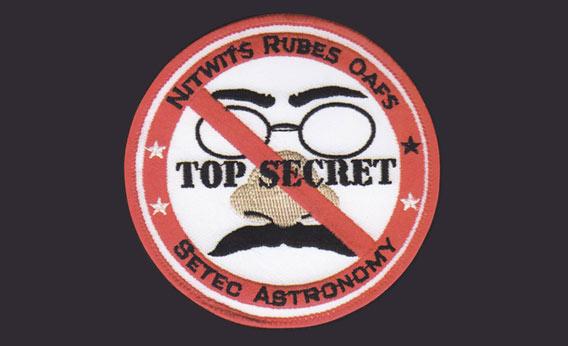A few years ago, artist and photographer Trevor Paglen collected several dozen military patches and published them in a slim volume, I Could Tell You … but Then You Would Have To Be Destroyed by Me. The twist: The patches, laced with obscure symbols and black humor, had been made by U.S. black-ops organizations. One in particular, from the National Reconnaissance Office—the agency that manages American spy satellites—stood out to me, for its use of the name “Setec Astronomy,” a key phrase from the film Sneakers. Why would a secretive government organization, one that could probably tell time by taking a photo of my watch from space, allude to a lighthearted 1992 caper movie?
I started my investigation by calling Paglen, who, for someone whose research had taken him within spitting distance of the most highly guarded work of the Pentagon, sounded awfully cheery. An NRO member, he told me, would likely have earned the patch through achievement on the job, or the patch might have signified that its wearer was qualified for a certain kind of operation. But mainly, patches like this were “souvenirs for the guys,” he said, often allowed to be worn on casual Fridays.
Casual Fridays? It wasn’t a term I expected to hear when talking about the world of black ops. Also: What did they do, sew on new patches at the end of every week?
“Velcro!” said Paglen.
The word somehow managed to make the $50 billion-plus “black budget” sound somewhat less scary. But the coded phrasing on this patch and others, and the mysterious, even goofy iconography, seemed so carefully chosen and placed. The phrase “Nitwits, Rubes, and Oafs” runs along the top of the patch—cereal-box code for the NRO. In the center of the patch there’s a Groucho Marx disguise that has been firmly crossed out, a statement suggesting the office is perhaps pro-transparency. Yet “Top Secret” is then stamped over the cross-out, as if to take it back. Which one is it?
Then there’s the odd, cryptic arrangement of the four stars along the edge of the patch, three white and one black. When I asked Paglen about them, he said that imaging satellites often work in groups of four called “constellations” (hence the stars); the dark one may signify the satellite of a particular squad.
I was uncertain how seriously to take the patch’s shout-out to Sneakers, a film that’s as much a comedy as thriller. But odd connections were starting to suggest themselves to me, as they might have to Mother, Dan Aykroyd’s conspiracy theorist character in the movie. In his book, Paglen goes so far as to say that the word “Oafs” itself might be an acronym for “Onizuka Air Force Station.” He explained to me that Onizuka was once a downlink site for imaging satellites in Sunnyvale, Calif. (It closed in 2010.) “Hey, Sneakers takes place near there,” I said, considering it little more than a coincidence.
At this point Paglen made clear that this was the limit of what he could infer from the symbols. He had no idea what the particular mission might have been, what satellite might have been involved, or even when the patch was made, though he noted that it must have been after 1992, the year Sneakers was released.
Unless—I joked—unless “Setec Astronomy,” and its anagram, “too many secrets,” was already an NRO code before the movie’s writers stumbled upon it.
Paglen laughed.
“Oh, I think I remember what happened with this patch now,” he said quietly. Someone had gotten in trouble for it having been made public. “There had been … a witch hunt.”
I pressed him for details. “I really can’t say more,” he said.
But then he told me, like Deep Throat counseling a young Woodward, to look up an unclassified 2008 memo from the director of the NRO. What it said did little to quiet the strange, half-formed suspicions starting to nag at me:
Recently, two journalists compiled an article mentioning how symbols used in unclassified logos and patches can reveal information about National Reconnaissance Office (NRO) satellite identities and missions that are otherwise classified. … All briefed personnel are reminded … [of] the grave responsibility of protecting that information from improper and unauthorized disclosure and compromise. Failure to comply with these obligations can result in irreparable harm to the nation.
Suddenly it didn’t seem so silly a coincidence that the existence of the NRO wasn’t officially declassified until Sept. 18, 1992, only nine days after Sneakers—and “Setec Astronomy”—had been released to theaters nationwide.
There was no point in delaying any longer. A pleasant-sounding woman from the NRO’s communications department answered the phone. She promised someone would call me back to talk about the patch. No one did. I called again, and again was told someone would call me back. I saw where this was going. Just before hanging up, I was tempted to blurt out “Setec Astronomy” and see where it got me; perhaps, as in the film, James Earl Jones would get on the line and offer to guarantee my safety. And, having seen the film, I would know not to believe him.
Also in Slate’s celebration of the 20th anniversary of the movie Sneakers: John Swansburg and Julia Turner discuss the film’s enduring appeal; actor Stephen Tobolowsky fondly recalls his role as Werner Brandes; and Lowen Liu attempts to re-create one of the movie’s most memorable scenes.
